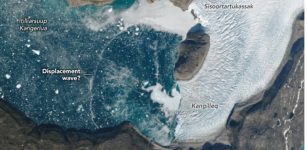Unraveling The Mysteries Of Fog In Complex Terrain
Eddie Gonzales Jr. – MessageToEagle.com – Fog is considered one of the most mysterious of the world’s various weather phenomena.
In the winter of 2022, U researchers operated this site near Deer Creek Reservoir where they installed a trove of meteorological instrumentation for an intensive study of fog formation. Credit: Zhaoxia Pu
The physical processes resulting in fog formation are extremely complex, and the phenomenon is considered a major hazard to transportation safety.
Meteorologists focus their studies to figure out how to forecast it with the precision they have achieved for precipitation, wind and other stormy events.
The recent study is focusing on a northern Utah and more precisely on the Heber Valley. Utah researchers shed new light on how fog forms in mountainous areas, providing insights for improving forecasts for a weather phenomenon that poses serious travel hazards. Located about 50 miles southeast of Salt Lake City, Heber Valley is nestled behind the Wasatch Mountains and framed by two major reservoirs on the Provo River.
“Our understanding is limited. In order to accurately forecast fog we should better understand the process that controls fog formation,” Zhaoxia Pu, a professor of atmospheric sciences at the University of Utah, said in a press release.
Winter nights create favorable conditions for different forms of fog, such as cold-air pool fog, ephemeral mountain valley fog and radiative ice fog.
A 32-meter tower rises above the site near Deer Creek Reservoir where U researchers installed a trove of meteorological instrumentation in January 2022 for an intensive study of fog formation. Credit: Zhaoxia Pu
The Heber Valley project homed in on cold-air fog which forms in freezing temperatures below zero degrees Celsius, according to Pu. However by observing how these varying kinds of fog form and dissipate, the researchers are continuing to learn about the meteorological conditions and physical processes governing the formation of fog.
For example, fog is the second leading cause of aircraft accidents after high winds. It leads to automobile crashes and disrupts ferry operations. Between 1995 and 2004 in the United States, 13,720 have died in fog-related accidents.
Improving fog forecasting would make traveling more safe, Pu said.
Today, most forecasting uses a computer model known as Numerical Weather Prediction (NWP), but the current computer model doesn’t work well for fog, researchers say.
Pu’s team hopes that improvements can be made using the masses of data they gathered over seven weeks in the winter of 2022 at several sites in the Heber Valley.
This map of Utah’s Heber Valley indicates where U researchers operated monitoring equipment for their 2022 fog study. Credit: University of Utah
“Fog involves a lot of physics processes so it requires a computer model that can better represent all these processes,” Pu said. “Because fog is clouds near the ground, it requires a high-resolution model to resolve it, so we need models at a very fine scale, which are computationally very expensive. The current models (relatively coarser in resolution) are not capable of resolving the fog processes, and we need to improve the models for better fog prediction.”
The ground is cooling overnight while denser, cooler air drops from mountain tops collecting in the valleys, in a phenomenon known as “cold air drainage.” Cooled by the ground, the dropping air temperature can approach the dew point, and if there is sufficient moisture in the air, fog begins to form, becoming the most dense around sunrise when surface temperatures are lowest.
The team set up two major data-collecting stations, one near Deer Creek Reservoir and another a few miles up the Provo River. These are low spots in the valley, about 5,450 feet above sea level, that see the densest fog. These sites were equipped with 100-foot towers to support an array of instruments that captured various meteorological data associated with humidity, wind, visibility, temperature, even snow depths, and soil moisture. The recordings were made from both in situ and remote-sensing platforms.
Additionally, the team recorded a lesser array of data points at nine satellite sites.
Written by Eddie Gonzales Jr. – MessageToEagle.com Staff Writer













